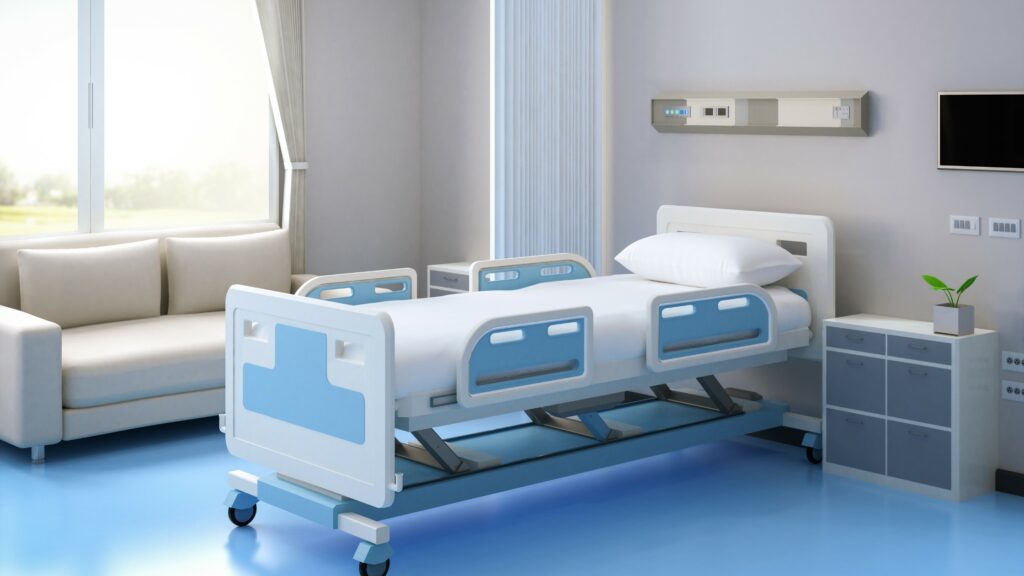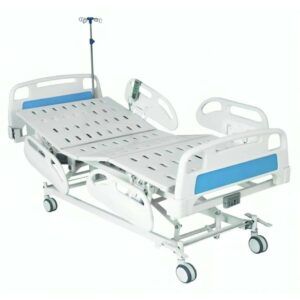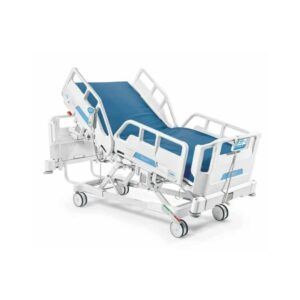Equipping your healthcare facility with the right hospital beds is crucial for patient care, staff efficiency, and overall operational effectiveness. This comprehensive B2B guide will walk you through everything you need to know about hospital beds, including understanding their importance, types available, key considerations for selection, and the benefits they offer.
Understanding Hospital Beds
Hospital beds are specialized pieces of medical equipment designed to enhance patient comfort and facilitate healthcare delivery. They are integral to patient care, offering both comfort and safety while providing healthcare professionals with the necessary tools to deliver optimal treatment.
- Essential Purpose: Hospital beds are crafted to support various medical needs, from routine rest to intensive care, ensuring patient comfort and safety.
- Key Components: These beds feature adjustable height, head and foot sections, side rails, and wheels for mobility, catering to diverse patient needs.
- Patient-Centric Design: Customizable positions and pressure-relief mattresses enhance patient comfort, aiding in quicker recovery and better care.
Types of Hospital Beds
- Manual Hospital Beds: Adjusted using hand cranks located at the foot of the bed. These beds are a cost-effective solution ideal for healthcare facilities with budget constraints. They offer basic functionalities such as height adjustment and head/foot section elevation, making them suitable for patients with lower mobility needs.
- Semi-Electric Hospital Beds: Combine the convenience of electric adjustments for the head and foot sections with manual height adjustment. These beds are perfect for facilities that require more flexibility than manual beds provide but at a lower cost than fully electric options. They strike a balance between affordability and ease of use.
- Fully Electric Hospital Beds: Offer complete motorized control for all adjustments, including height, head, and foot sections. These beds are ideal for facilities prioritizing patient comfort and staff convenience. They are equipped with user-friendly controls, making adjustments effortless for both patients and caregivers.
- ICU Beds: Designed for intensive care units and critical care settings. These beds feature advanced functionality, including integrated scales, cardiac chair positions, and CPR functions. ICU beds provide comprehensive adjustability to accommodate the complex needs of critically ill patients, ensuring optimal care and safety.
- Bariatric Beds: Reinforced to support heavier patients, offering higher weight capacities and wider frames. These beds are essential for facilities that cater to obese patients, ensuring safety and comfort. Bariatric beds come with features like heavy-duty motors and durable construction to withstand increased weight.
- Low Beds: Designed to minimize the risk of patient falls, making them ideal for patients with high fall risk or mobility issues. These beds can be lowered close to the floor and are often used in long-term care facilities. Low beds provide a safe environment, reducing the likelihood of injuries from falls.
- Pediatric Beds: Pediatric beds are specifically designed for infants and children. These beds include safety features like side rails and size-appropriate dimensions to ensure the safety and comfort of younger patients. Pediatric beds are essential in pediatric units, offering specialized care for children.
- Adjustable Beds: Adjustable beds provide a high level of customization, allowing for various positions to suit patient needs. These beds are often used in both hospital and home care settings. They offer functionalities such as Trendelenburg and reverse Trendelenburg positions, enhancing patient comfort and therapeutic outcomes.
- Transport Beds: Known as stretcher beds, are designed for moving patients within the hospital. These beds are lightweight, mobile, and equipped with features like locking wheels and easy maneuverability. Transport beds are crucial for patient transfers, ensuring safety and ease of movement.
- Cardiac Beds: Designed for patients with heart conditions, offering features like cardiac chair positions that facilitate easier breathing and circulation. These beds are essential in cardiac care units, providing specialized support for patients with cardiovascular issues
Key Considerations for Selecting Hospital Beds
- Mobility: Consider beds with easy adjustability for patients with limited mobility.
- Weight Capacity: Ensure the bed can safely support the patient’s weight.
- Condition-Specific Features: Specialized beds for conditions like spinal injuries or cardiac issues.
- Adjustability: Look for beds with multiple positions for head, foot, and height adjustments.
- Safety Features: Robust safety features like side rails and emergency CPR functions are essential.
- Durability: Ensure the bed is built to withstand rigorous use and offers long-term reliability.
- Initial Cost: Balance between budget constraints and required features.
- Maintenance: Consider long-term maintenance costs and the availability of parts.
- Warranty: Check the warranty and after-sales service provided by the manufacturer.
- Space Constraints: Ensure the bed fits within the space without obstructing movement.
- Staff Training: Choose beds that your staff can operate easily and safely.
- Integration with Other Equipment: Ensure compatibility with other medical devices for seamless operation.
Benefits of Hospital Beds
- Customizable Positions: Adjustable features improve comfort for various medical conditions, aiding in faster recovery.
- Pressure Relief: Specialized mattresses prevent bedsores and pressure ulcers, enhancing patient well-being.
- Ease of Use: Electric adjustments reduce physical strain on caregivers, allowing them to focus more on patient care.
- Accessibility: Features like adjustable height and side rails facilitate easier patient care and medical procedures.
- Fall Prevention: Side rails and locking wheels prevent accidental falls, ensuring patient safety.
- Emergency Features: Quick-adjustment functions aid in emergencies, providing immediate response capabilities.
- Mobility: Wheels allow for easy transport within the facility, enhancing operational flexibility.
- Durability: High-quality beds reduce the need for frequent replacements, saving costs in the long run.
Top Manufacturers of Hospital Beds
Willson Medical Systems Pvt. Ltd
Willson Medical Systems Pvt. Ltd. (WMSPL), established in 2011, is a premier manufacturer in the healthcare industry with over 20 years of experience. Renowned for its exquisite craftsmanship and reliable quality, WMSPL has developed a strict and unique quality management system that has earned global acclaim. The company’s new production base in Eastern India, spanning over 50,000 square feet, boasts an impressive production capacity of 100,000 beds per year.
WMSPL’s state-of-the-art facilities include CNC Laser Cutting Machines, Metal Mold Processing Equipment, Automatic Robot Welding Production Line, Automatic Powder Coating Line, and Finished Product Assembly Line. These investments ensure high production quality and full control over the manufacturing process. The company’s relentless focus on innovation and its high-quality foreign research and development team position WMSPL as a leader in the industry.
The WM-5176-7FC Motorised ICU Bed, a product of WMSPL, exemplifies advanced medical equipment designed for optimal patient care in intensive care units. This bed features a four-section mattress area made of durable CRCA sheet, detachable polymer molded head and foot boards, and four sectional safety side rails with angle indicators. For emergency situations, it includes a dual side lever for manual CPR and corner PU buffers for impact absorption. The bed also offers a heavy-duty telescopic IV pole with two hooks and central locking castor wheels for smooth mobility. Its pretreated and epoxy powder-coated metal components ensure durability and hygiene, making the WM-5176-7FC a top choice for healthcare facilities aiming to enhance patient care and safety.
VNG Medical Innovation System
VNG Medical Innovation System, an India-based company, has been manufacturing medical devices for over 21 years. Specializing in neonatal medical devices, VNG Medical is dedicated to enhancing the quality of neonatal healthcare globally. They manufacture other medical device accessories as well. A hard working team with able management look forward to achieve the goal of quality production. Their wide range of products include Hospital Beds that is popular across India and worldwide.
The EH145 – ICU Bed Hi-Low Motorized Five Function by VNG Medical Innovation System is a state-of-the-art ICU bed designed for optimal patient care. This motorized bed offers five functions for complete patient comfort, including adjustments for head, foot, height, Trendelenburg, and reverse Trendelenburg positions. This bed is compatible with standard electrical systems, requiring a power supply of 100v-120v, 50Hz/60Hz.
Ostrich Mobility Instruments Private Limited
Ostrich Mobility Instruments Private Limited is the market leader in India for designing and developing hospital care beds alongwith powered wheelchairs, mobility scooters etc. With a blend of skills, tools, and systems, Ostrich Mobility creates unique and innovative products that offer independence, freedom, and safety to users. Using patented technologies, Ostrich Mobility produces feature-rich products suitable for Indian conditions.
The Intimate IC500R Electric Bed by Ostrich Mobility is a versatile and advanced medical device. It features adjustable positions including trendelenburg, reverse trendelenburg, and backrest adjustment. The bed is equipped with ABS side railings, one-hand release, and transport handles for convenience and safety. Ostrich Mobility ensures high-quality electric beds with onsite delivery and service.
Choosing the right hospital beds is a critical decision that impacts patient care and facility operations. By understanding the different types, key considerations, and benefits, you can make an informed choice that ensures the well-being of patients and the efficiency of healthcare professionals. Equip your facility with the best hospital beds and experience the difference in care and comfort.
Disclaimer: This buying guide provides general information and should not replace professional advice and guidance



